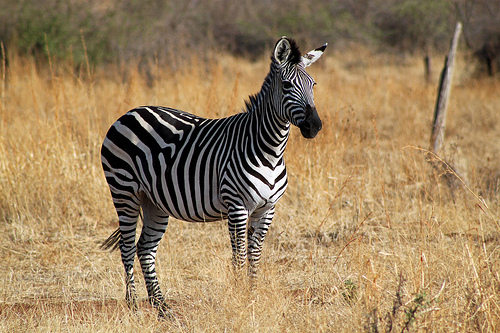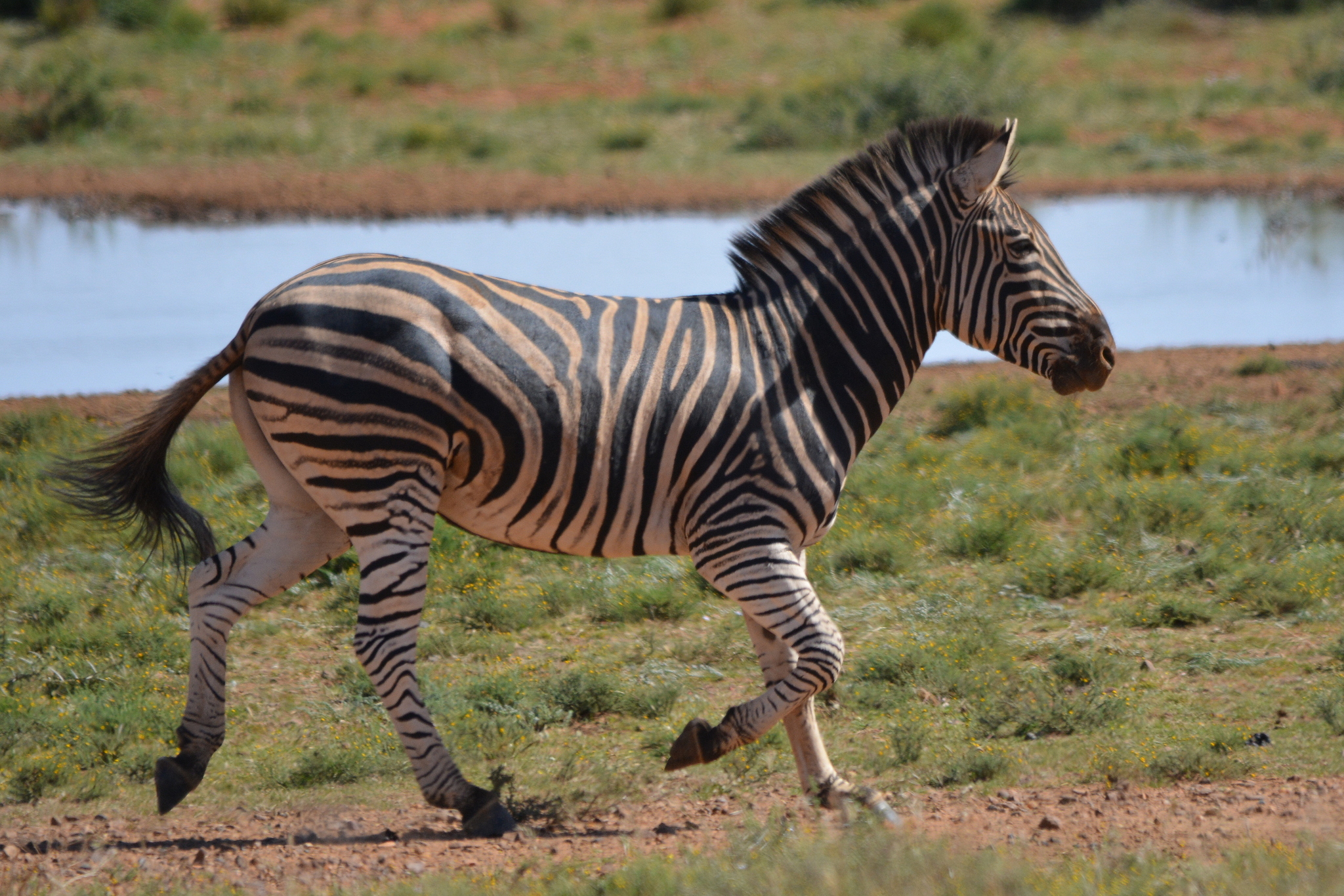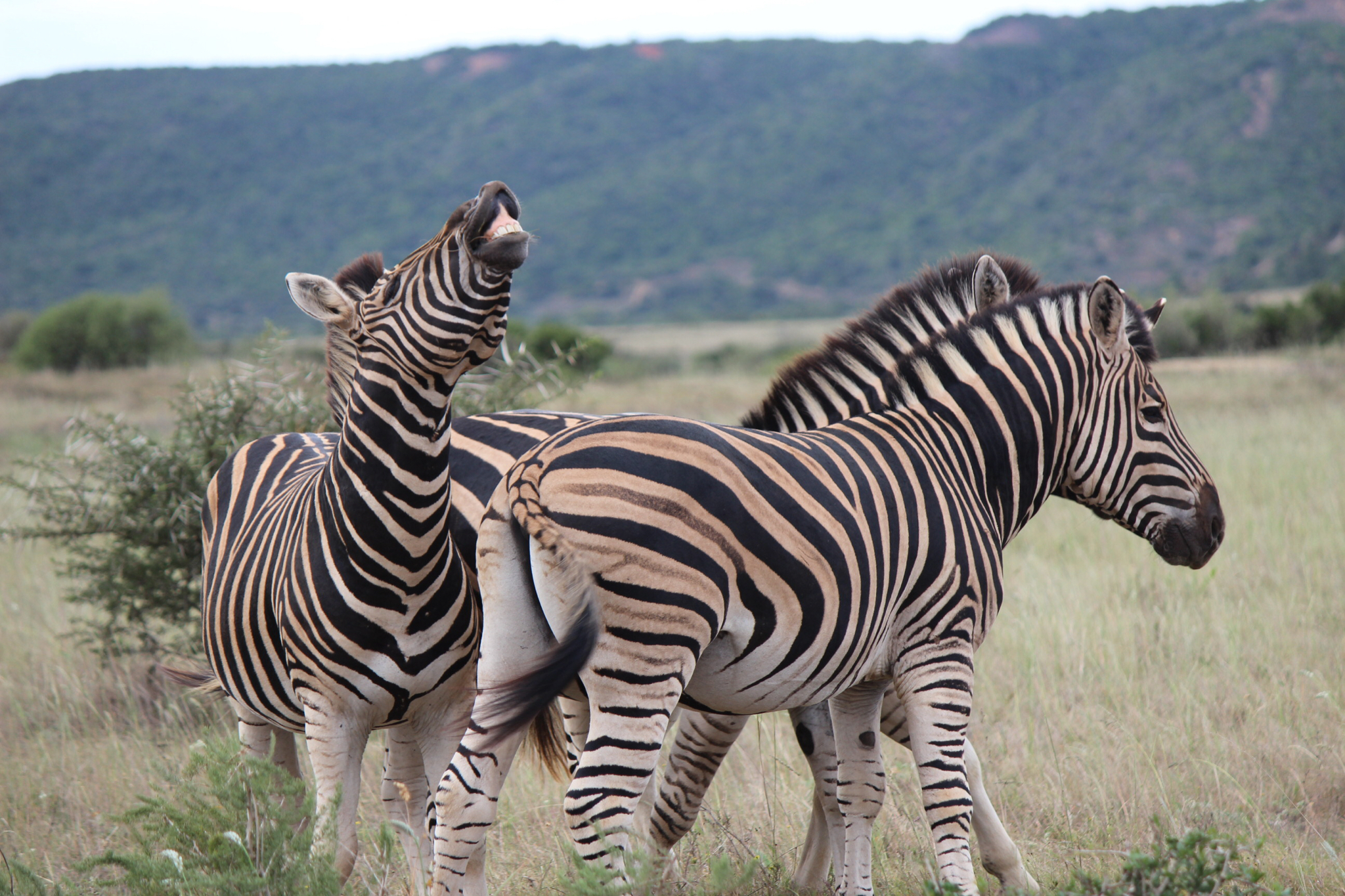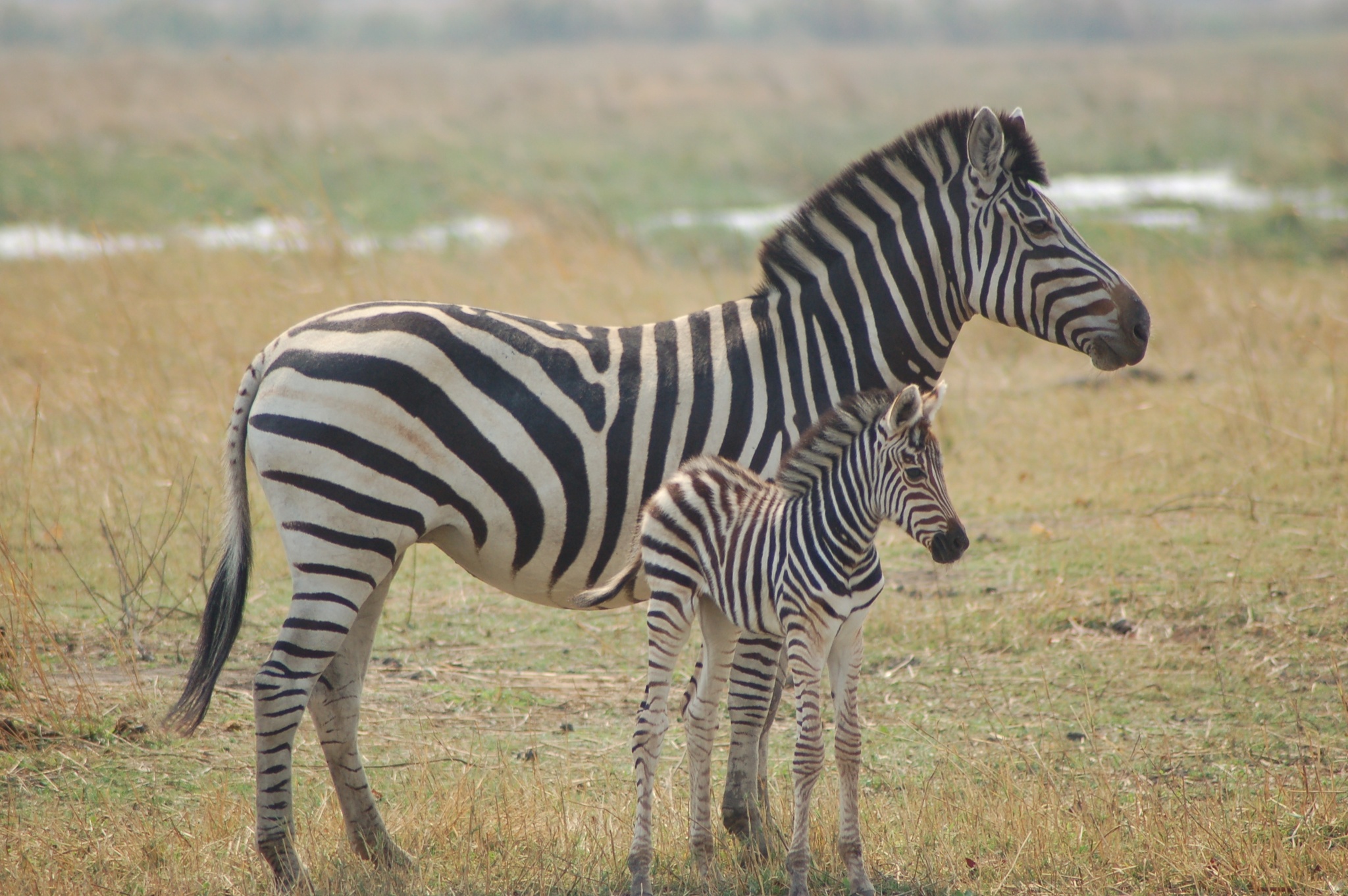- Home
- Conservancy
- Plain Zebra
Description
The plains zebra (Equus quagga, formerly Equus burchellii), also known as the common zebra or Burchell's zebra, or locally as the "quagga (not to be confused with the extinct subspecies), is the most common and geographically widespread species of zebra.It ranges from the south of Ethiopia through East Africa to as far south as Botswana and eastern South Africa. The plains zebra remains common in game reserves, but is threatened by human activities such as hunting for its meat and hide, as well as competition with livestock and encroachment by farming on much of its habitat.
Subspecies include the extinct quagga and six recognised extant subspecies, though there is great variation in coat patterns between individuals. The striping pattern is unique among ungulates in the region, and its functions are disputed. Suggested functions include crypsis, forms of motion camouflage, social signaling and recognition, and discouraging biting flies. As of 2016, the plains zebra is classified as Near Threatened by IUCN.
The plains zebra's range is fragmented, but spans much of southern and eastern Africa south of the Sahara. Its habitat is generally but not exclusively treeless grasslands and savanna woodlands, both tropical and temperate. They generally avoid desert, dense rainforest and permanent wetlands, and rarely stray more than 30 kilometres from a water source. Zebras of all ages are preyed upon by lions, spotted hyenas, leopards, cheetahs, crocodiles and African wild dogs.
The plains zebra is a highly social species, forming harems with a single stallion, several mares and their recent offspring; there are also bachelor groups. Groups may come together to form herds. The animals keep watch for predators rather than attempting to hide; they bark or snort when they see a predator, and the harem stallion attacks predators to defend his harem. The species population is stable and not endangered, though some populations such as in Tanzania have declined sharply.
Fun Facts
Function Of The Stripes
The striping pattern of the zebra is unique among sympatric ungulates. One suggested function for the stripes is to provide crypsis for the animal in tall grass or in the dappled shade beneath bushes and trees.However, cryptically coloured species, such as the kudu and bushbuck, tend to be quiet and stealthy. They freeze when there is danger and flee only at the last moment. By contrast, the zebra is active and noisy,and makes no attempt to hide itself. Another suggestion is motion camouflage, that the stripes affect a predator's judgement of the zebra's size, distance and what direction it is going in. A 2014 study supports this hypothesis, finding that, when moving, the stripes may confuse observers, such as mammalian predators and biting insects, via two visual illusions, the wagon wheel effect, where the perceived motion is inverted, and the barber pole illusion, where the perceived motion is in a wrong direction.A related hypothesis is that the stripes make it difficult for a predator to single out and learn about an individual during a chase.
Perhaps the best explanation for the stripes is that they serve a social function.Individual zebras can apparently recognise each other by their striping patterns. The stripes may also serve as visual cues for grooming.In addition, they could serve to help zebra groups stay together when they are fleeing.\A 2012 study suggests that stripes may have developed to discourage biting flies. Experiments have demonstrated that the stripes polarize light in such a way that it discourages tabanids (biting flies) in a manner not shown with other coat patterns.Another study from 2015 determined that environment temperature is a strong predictor for zebra striping patterns and proposed that the stripes may be related to thermoregulation.
Ecology
Range And Habitat
Plains zebra are highly dependent on water
The plains zebra's range stops short of the Sahara from South Sudan and southern Ethiopia extending south along eastern Africa, as far as Zambia, Mozambique, and Malawi, before spreading into most southern African countries. They are regionally extinct in Burundi and Lesotho, and they may have lived in Algeria in the Neolithic Era.
Plains zebras generally live in treeless grasslands and savanna woodlands[12] but can be found in a variety of habitats, both tropical and temperate. However they are generally absent from deserts, dense rainforests and permanent wetlands.[12] Zebras also live in elevations from sea level to 4,300 m on Mount Kenya. They rely on rainfall for food and water, and go on great migrations to follow the rains. The zebras will migrate up to 700 miles (1,100 km) for food. Other grazers also migrate. Plains zebras are highly water-dependent[6] and are usually found within 25–30 kilometres of a water source.
Diet And Predation
In one study, the zebra's diet was estimated to be 92% grass, 5% herbs, and 3% shrubs.] Unlike many of the large ungulates of Africa, the plains zebra does not require (but still prefers) short grass to graze. It eats a wide range of different grasses, preferring young, fresh growth where available, and also browses on leaves and shoots from time to time. In consequence, it ranges more widely than many other species, even into woodlands, and it is often the first grazing species to appear in a well-vegetated area. Zebras have a simple stomach and use hindgut fermentation (caeco-colic), which allows them to digest and assimilate larger amounts of forage during a 24-hour period. Thus, zebras are less selective in foraging, but they do spend much time eating. The zebra is a pioneer grazer and prepares the way for more specialised grazers like blue wildebeests and Thomson's gazelles which depend on shorter and more nutritious grasses.
The plains zebra's major predators are lions and spotted hyenas. Nile crocodiles are also great threats during migratory river crossings. Wild dogs, cheetahs, and leopards also prey on zebras, although the threats they pose are generally minor and they mostly attack the foals. Olive baboons may prey on foals, but pose no threat to adults. The zebra can be a formidable adversary, since they have a strong bite and a kick powerful enough to kill land predators. They often try to outrun larger predators such as lions and spotted hyenas, whereas they often stand their ground with the smaller predators.
Behaviour & Social Structure.
The plains zebra is highly social and usually forms small family groups called harems, which consist of a single stallion, several mares, and their recent offspring. The adult membership of a harem is highly stable, typically remaining together for months to years. Groups of all male "bachelors" also exist. These are stable groups of 2-15 males with an age-based hierarchy led by a young male.These males stay in their groups until they are ready to start a harem. The bachelors prepare for their adult roles with play fights and greeting/challenge rituals, which take up most of their activities. Multiple harems and bachelor groups come together to form larger herds of hundreds of animals, especially during migrations. Plains zebras are unusual among harem-holding species in forming these groups. In addition, pairs of harems may create temporarily stable subgroups within a herd, allowing individuals to interact with those outside their group.Among harem-holding species, this has only been observed in primates like the gelada and the hamadryas baboon.
Stallions form and expand their harems by abducting young mares from their natal harems. When a mare reaches sexual maturity, she will exhibit the oestrous posture, which attracts nearby stallions,both bachelors and harem leaders. Her family stallion (likely her father) will chase off or fight stallions attempting to abduct her. Even after a young mare is isolated from her natal harem, the fight over her continues until her estrous cycle is over, and it starts again with the next estrous cycle.[28] It is rare that the mare's original abductor keeps her for long. When the mare finally ovulates, the male that impregnates her keeps her for good. Thus, the mare becomes a permanent member of a new harem.The estrous posture of a female becomes less noticeable to outside males as she gets older, hence competition for older females is virtually non-existent.
Mares exist in a hierarchy, with the alpha female being the first to mate with the stallion and being the one to lead the group. When new mares are added to the group, they are met with hostility by the other mares. Thus, the stallion must shield the new mares until the aggression subsides. The most recently added females rank lowest. Females that become unfit or weak may drop in their rank, though. The female membership of a harem stays intact even if a new stallion takes over. Zebras strengthen their social bonds with grooming. Members of a harem nip and scrape along the neck, withers, and back with their teeth and lips. Mothers and foals groom the most often, followed by siblings. Grooming shows social status and eases aggressive behaviour.
A stallion will defend his group from other males. When challenged, the stallion issues a warning to the invader by rubbing nose or shoulder with him. If the warning is not heeded, a fight breaks out. Zebra fights often become very violent, with the animals biting at each other's necks, heads or legs, wrestling to the ground, and occasional kicking. Sometimes a stallion will lie still on the ground as if surrendering, but once the other male lets up, will strike and continue the fight. Most fighting occurs over young mares in estrus, and as long as a harem stallion is healthy, he will usually not be challenged. Only unhealthy stallions have their harems taken over, and even then the new stallion gradually takes over pushing the old one out without a fight.
Communication
At least six different calls have been documented for the plains zebra. One of which is its distinctive high-pitched contact call (commonly called "barking") heard as "a-ha, a-ha, a-ha" or "kwa-ha, kaw-ha, ha, ha" also transcribed as "kwahaah",or "oug-ga".The species name quagga is derived from the Khoikhoi word for "zebra" and is onomatopoeic for its call.When a predator is sighted, a zebra will make a two-syllable alarm call. A loud snort is made when moving in cover of potential danger. When in contentment, a zebra will make a more drawn-out snort. Males will make a short high-pitched squeal when hurt and foals will emit a drawn out wail when in distress.There are two main facial expressions made by zebras. One is for greeting and involves the ears sticking up and directed forward; the other is threatening and involves the ears down




